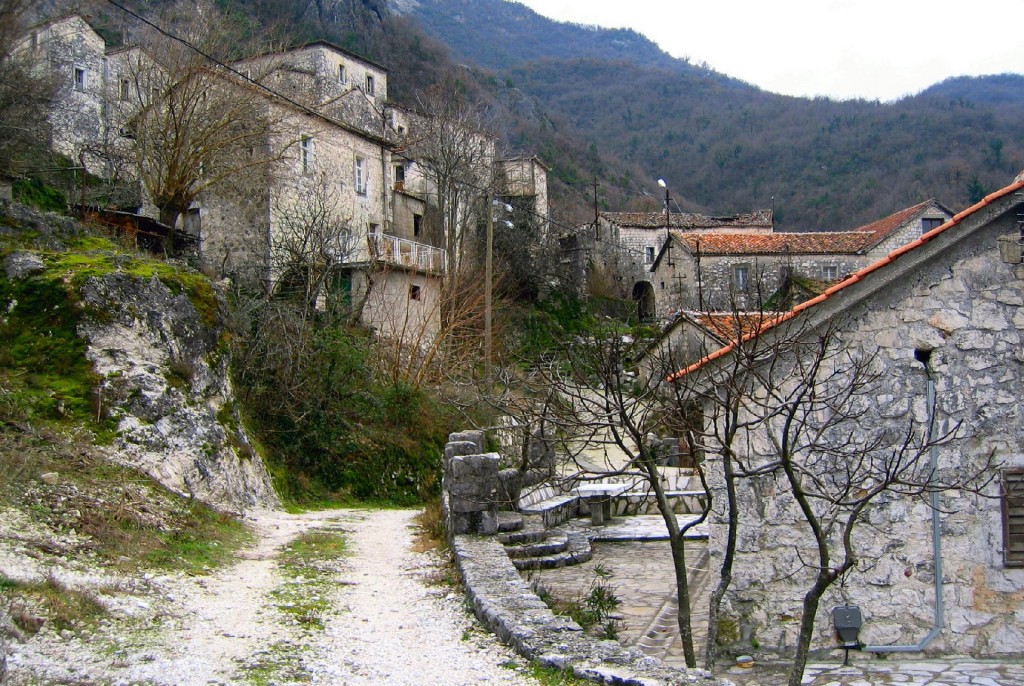 Skadar Lake has so much to offer, especially the western and southern shores with their hidden hamlets, islets and monasteries.
Skadar Lake has so much to offer, especially the western and southern shores with their hidden hamlets, islets and monasteries.
One of the most interesting villages in this area is, no doubt, Godinje, situated on the fourth kilometer of the road from Virpazar to Ostros. This rural settlement, with 60 inhabitants only, is situated on the hillside and has an interesting chain-like system of fortified houses, connected by passageways and tunnels in between them (photo 1).
The architecture is really unique, also due to the arched wine cellars and spacious terraces looking out over the Lake.
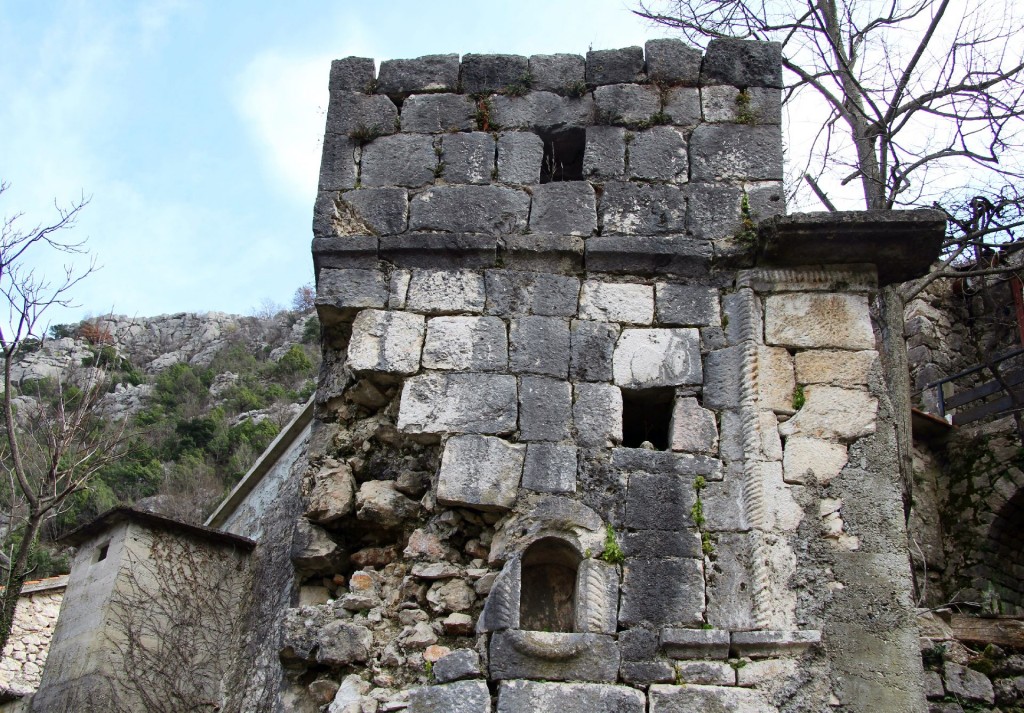 As I knew that, many years ago, plans had been made to preserve and renovate this authentic village with the aim to make it attractive for tourists, I was very curious to see how it looks like today. And so we made a hiking tour around Godinje and further through Nikači, starting from the parking lot beside the road.
As I knew that, many years ago, plans had been made to preserve and renovate this authentic village with the aim to make it attractive for tourists, I was very curious to see how it looks like today. And so we made a hiking tour around Godinje and further through Nikači, starting from the parking lot beside the road.
Climbing the narrow and steep road to the village center, the first structure we saw was a large threshing floor. The village itself looked like a kind of fortress. Of course, this was easy to understand. In the old times, the villagers had to defend themselves from attacks by the Ottomans and that is the reason why they built their houses in this way (photo 2).
 According to the legend, the history of Godinje dates back to the 10th century. Prince Jovan Vladimir liked this area (the word “goditi” means give pleasure”) and that is why the village got this name.
According to the legend, the history of Godinje dates back to the 10th century. Prince Jovan Vladimir liked this area (the word “goditi” means give pleasure”) and that is why the village got this name.
The summer residence of the Balšića Dynasty from the14th century is the oldest and most representative complex in Godinje. It was impressive to see the remnants of the main gate with spiral stone decorations and the family emblem (photo 3). The wall looked as if it could break down any minute and we asked a passer-by why such a historical monument is not maintained or even restored. He shrugged his shoulders and did not seem to be interested in such trivial issues. I really think that it is a shame to leave such an important historical corner to the ravages of time! And this also applies to many other houses in the village, which are obviously uninhabited, so that they will become dilapidated very rapidly. What a pity that the authorities have not taken any measures so far to maintain this settlement in its authentic form! Or even more: to revitalize it!
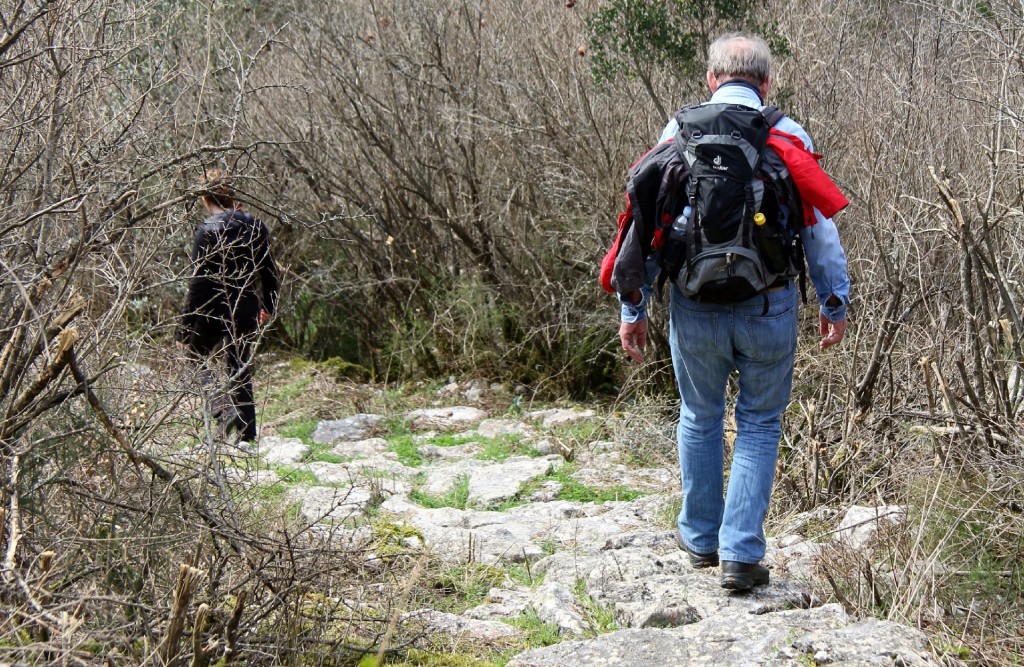 We were invited by the friendly villager to drink a glass of wine. Although we knew that the village has a rich tradition in cultivating the famous Vranac wine, we did not accept, as we still had a long way to go. And so we continued our hike through the village, uphill, looking for signposts or red-white marks, which were difficult to find. Due to the recent rainfall, the stone path was slippery and wet. It was nice to see the traditional architecture, with its cellars, water springs and the ruins of old mills. Leaving the village, we had to pass a turbulent brook. There was no bridge, just a few stones… and as I am not exactly an athlete, I could not avoid wetting my feet…
We were invited by the friendly villager to drink a glass of wine. Although we knew that the village has a rich tradition in cultivating the famous Vranac wine, we did not accept, as we still had a long way to go. And so we continued our hike through the village, uphill, looking for signposts or red-white marks, which were difficult to find. Due to the recent rainfall, the stone path was slippery and wet. It was nice to see the traditional architecture, with its cellars, water springs and the ruins of old mills. Leaving the village, we had to pass a turbulent brook. There was no bridge, just a few stones… and as I am not exactly an athlete, I could not avoid wetting my feet…
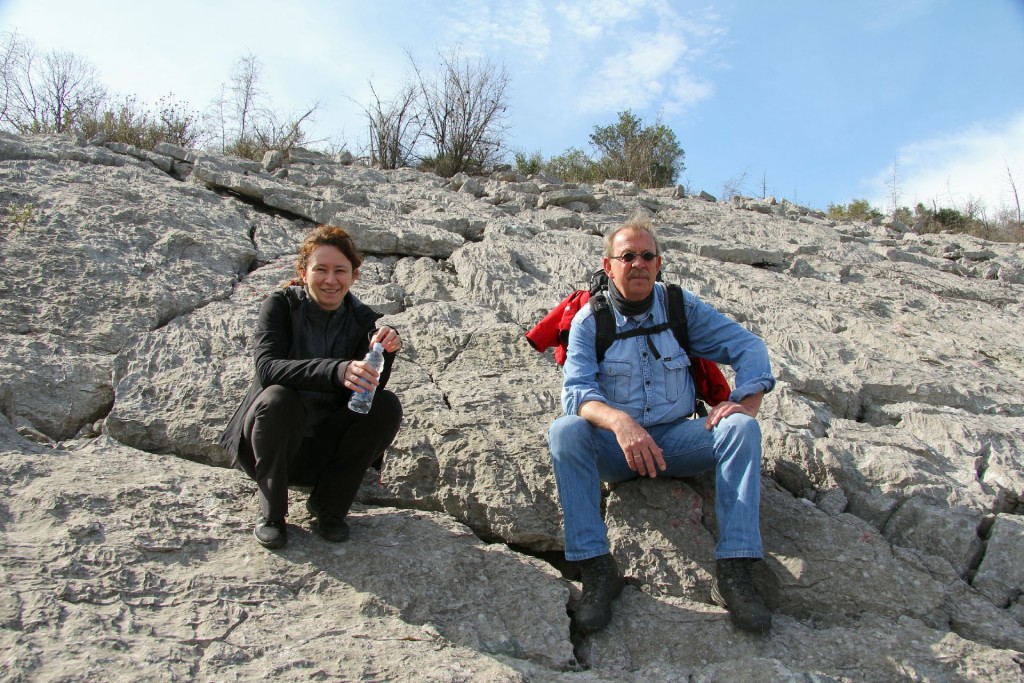 Never mind! Finally the path joined the asphalt road behind the Sveti Nikola church in the hamlet of Nikači (photo 4). This church, built in 1715, is the only active church of the village, out of four that existed in Godinje. We climbed the stairs behind the exterior of the altar and entered a small terrace on a natural rock, enclosed by a stone wall. From here, the view on Godinje and the Lake was magnificent. We had the strange feeling that the back part of the church was much higher than the front part – but I could not find any information about that. Was it a consequence of the 1979 earthquake that had damaged many buildings in the village? The road back to the parking lot led us through a rural area with beautiful vineyards. Obviously, many inhabitants of this area have built new houses in the valley, where they produce grapes and excellent wine, but also grape brandy.
Never mind! Finally the path joined the asphalt road behind the Sveti Nikola church in the hamlet of Nikači (photo 4). This church, built in 1715, is the only active church of the village, out of four that existed in Godinje. We climbed the stairs behind the exterior of the altar and entered a small terrace on a natural rock, enclosed by a stone wall. From here, the view on Godinje and the Lake was magnificent. We had the strange feeling that the back part of the church was much higher than the front part – but I could not find any information about that. Was it a consequence of the 1979 earthquake that had damaged many buildings in the village? The road back to the parking lot led us through a rural area with beautiful vineyards. Obviously, many inhabitants of this area have built new houses in the valley, where they produce grapes and excellent wine, but also grape brandy.
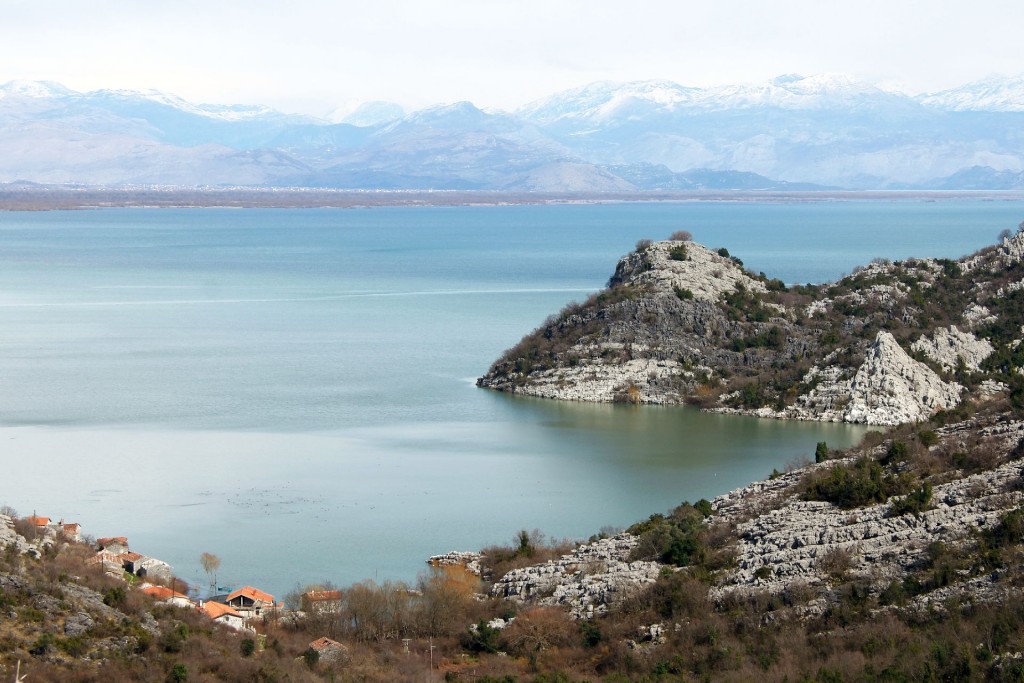 By car we continued our tour along the coastline until the signposts for the fishermen’s villages of Radus and Pristan, where we turned left. It is interesting to know that the western shore is so steep and mountainous that several villages, bays and peninsulas cannot be reached by car. And so we stopped near the church where a road sign showed the direction of Radus – a narrow footpath behind the graveyard (photo 5). What a beautiful path, even now, without green vegetation!
By car we continued our tour along the coastline until the signposts for the fishermen’s villages of Radus and Pristan, where we turned left. It is interesting to know that the western shore is so steep and mountainous that several villages, bays and peninsulas cannot be reached by car. And so we stopped near the church where a road sign showed the direction of Radus – a narrow footpath behind the graveyard (photo 5). What a beautiful path, even now, without green vegetation!
The trail was well-maintained and cleared, as it is the only way to reach the village by land. It leads through forests uphill to the steep karst slopes of the Strbina mountain. This was an ideal place for a rest (photo 6). Sitting on the barren rocks, we admired the view and then descended down again to the bay of Radus, in front of which – deep in the Lake – the so-called “eye” of Radus is located (photo 7). Although the average depth of Skadar Lake is around 6 meters, this “eye” is the deepest place in the Lake: even 60 meters (and maybe even deeper)! That means that this area is very rich with fish and, of course, birds. That is also the reason why an observation tower is located near the village. However, access to Radus by boat from the water is much easier and the picturesque hamlet (photo 8) is a favourite resting spot of boat excursions, there is even a small restaurant with a nice terrace during the season!
I am always eager to find something new in Montenegro – the walk to Radus is one of these things. It would be a good idea to promote this easy hike (first of all off-season, as I suppose that it is very hot during the summer months)!
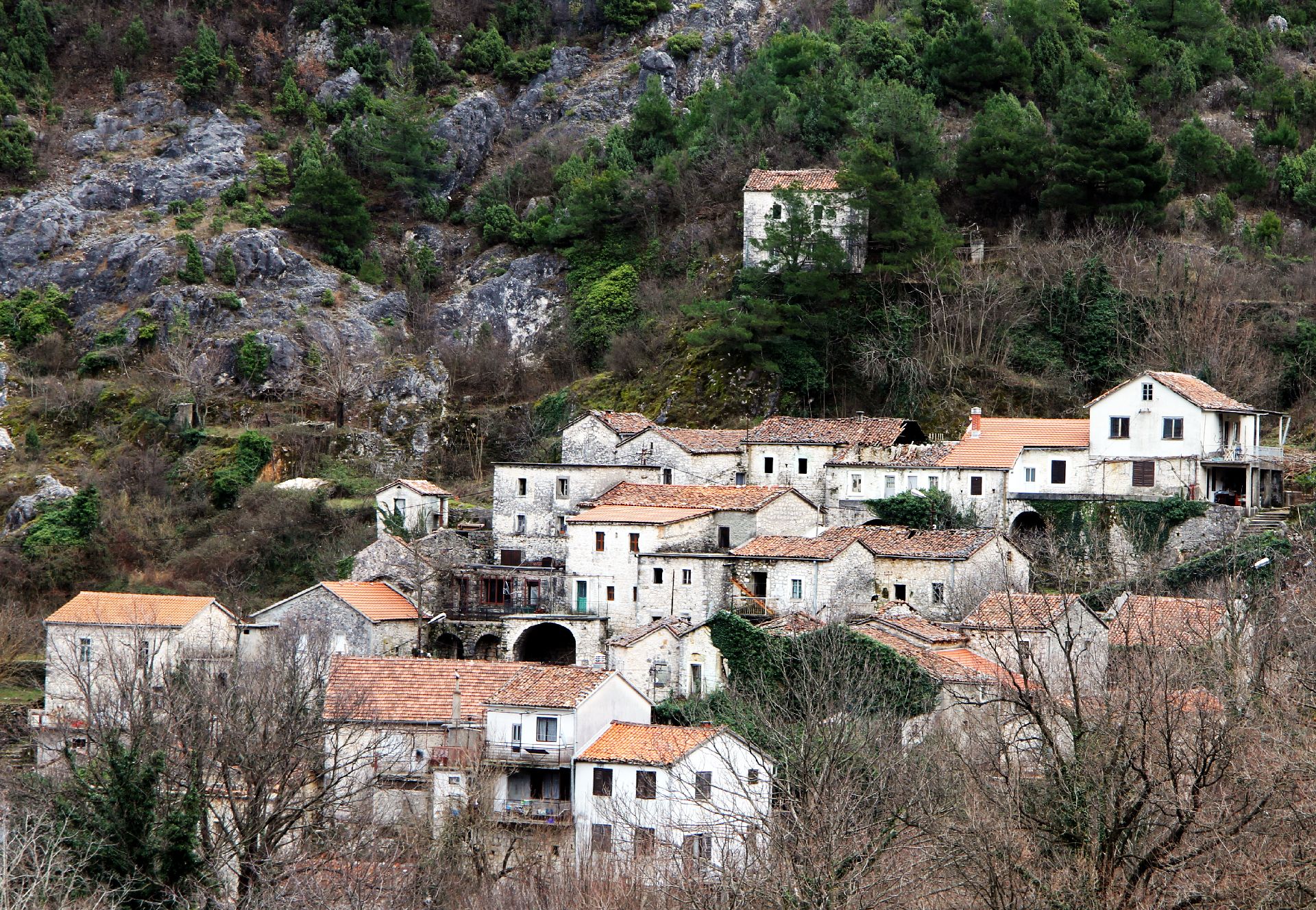
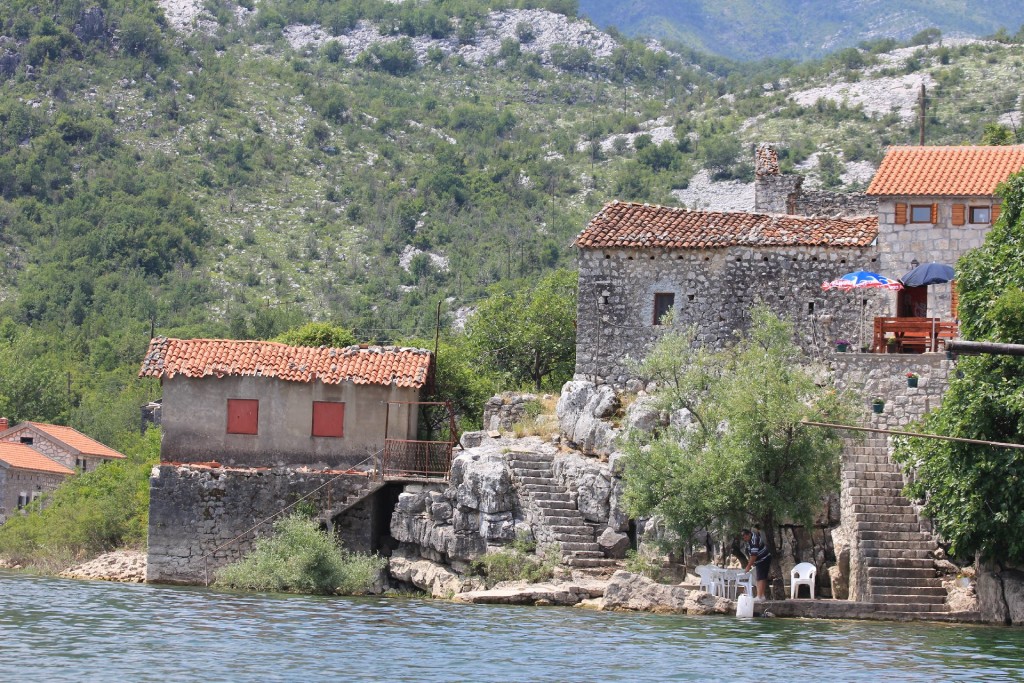
Always an interesting story. Thanks.
Great write up. Glad you’ve enjoyed. This summer, if around stop by. The house in the second picture on the right side, with leafless fig trees in front.
Thank you for your nice words. Hope to see you this summer!
Best regards, Marianne
Ik voel het nu al…..dit worden heerlijke ontmoetingen! Grz.
[…] the bay of Raduš (photo 4), in which the so-called “Eye of Raduš” is located (see: https://montenegro-for.me/2015/03/skadar-lake-between-godinje-and-radus/). Although the average depth of the Lake is around 6 meters, this “eye” is the deepest […]
[…] a cluster of old stone houses, built close to each other with thick walls and arched entrances (see Skadar Lake: between Godinje and Raduš). Red wine from this area is […]
We are visiting the area next summer.i am interested in seeing the real Montenegro,away form all the tourists. How long and difficult was the hike down to the fishing village, Radus?
Wat fijn om te horen dat ook andere gasten uil lage landen hier, in omgeving, aanwezig zijn. Mocht je nog een keer ff langskomen in Godinje, van harte welkom om een glaasje wijn of jenever te proeven. Ik heb, in de dorp, een oude huis gerestaureerd en ben doorgaans gehele zomer aanwezig. Meestaal bezig met restauratie of in de wijngaard. In iedere geval hele fijne artikel. Groeten.